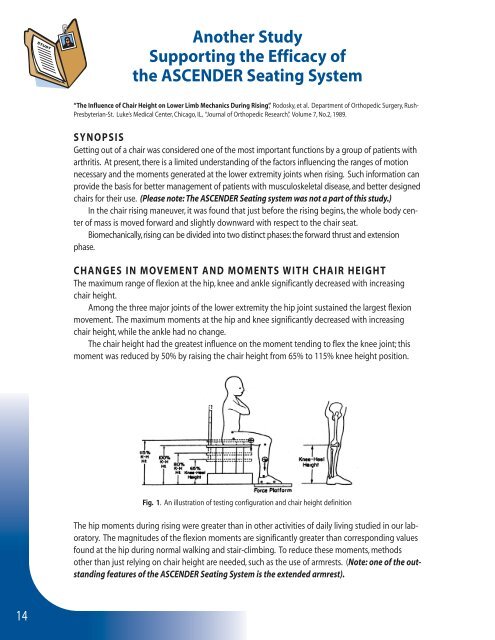Seating Solutions - Rehab Seating Systems, Inc.
Seating Solutions - Rehab Seating Systems, Inc.
Seating Solutions - Rehab Seating Systems, Inc.
Create successful ePaper yourself
Turn your PDF publications into a flip-book with our unique Google optimized e-Paper software.
14<br />
Another Study<br />
Supporting the Efficacy of<br />
the ASCENDER <strong>Seating</strong> System<br />
“The Influence of Chair Height on Lower Limb Mechanics During Rising”, Rodosky, et al. Department of Orthopedic Surgery, Rush-<br />
Presbyterian-St. Luke’s Medical Center, Chicago, IL, “Journal of Orthopedic Research”, Volume 7, No.2, 1989.<br />
SYNOPSIS<br />
Getting out of a chair was considered one of the most important functions by a group of patients with<br />
arthritis. At present, there is a limited understanding of the factors influencing the ranges of motion<br />
necessary and the moments generated at the lower extremity joints when rising. Such information can<br />
provide the basis for better management of patients with musculoskeletal disease, and better designed<br />
chairs for their use. (Please note: The ASCENDER <strong>Seating</strong> system was not a part of this study.)<br />
In the chair rising maneuver, it was found that just before the rising begins, the whole body center<br />
of mass is moved forward and slightly downward with respect to the chair seat.<br />
Biomechanically, rising can be divided into two distinct phases: the forward thrust and extension<br />
phase.<br />
CHANGES IN MOVEMENT AND MOMENTS WITH CHAIR HEIGHT<br />
The maximum range of flexion at the hip, knee and ankle significantly decreased with increasing<br />
chair height.<br />
Among the three major joints of the lower extremity the hip joint sustained the largest flexion<br />
movement. The maximum moments at the hip and knee significantly decreased with increasing<br />
chair height, while the ankle had no change.<br />
The chair height had the greatest influence on the moment tending to flex the knee joint; this<br />
moment was reduced by 50% by raising the chair height from 65% to 115% knee height position.<br />
Fig. 1. An illustration of testing configuration and chair height definition<br />
The hip moments during rising were greater than in other activities of daily living studied in our laboratory.<br />
The magnitudes of the flexion moments are significantly greater than corresponding values<br />
found at the hip during normal walking and stair-climbing. To reduce these moments, methods<br />
other than just relying on chair height are needed, such as the use of armrests. (Note: one of the outstanding<br />
features of the ASCENDER <strong>Seating</strong> System is the extended armrest).


